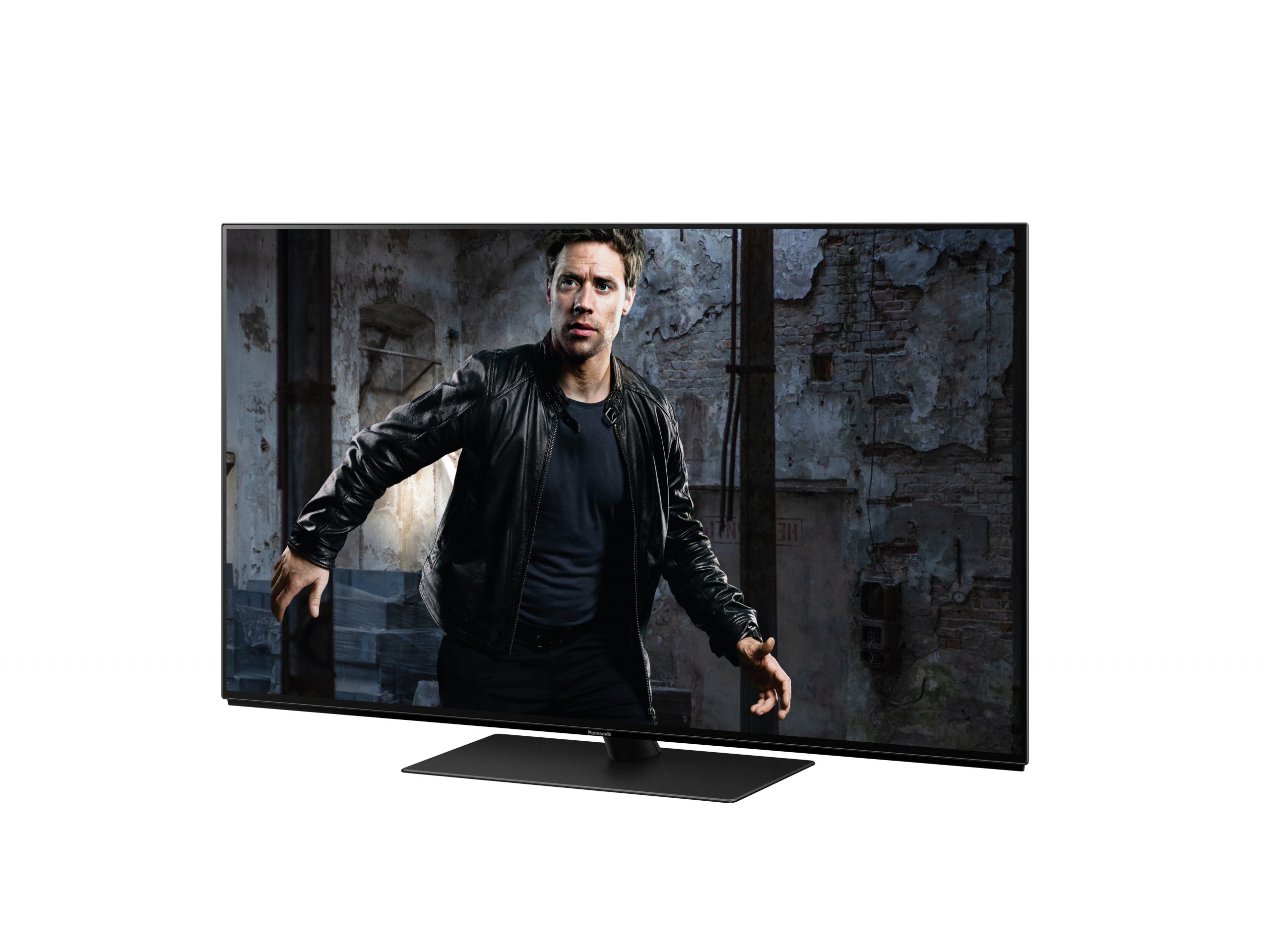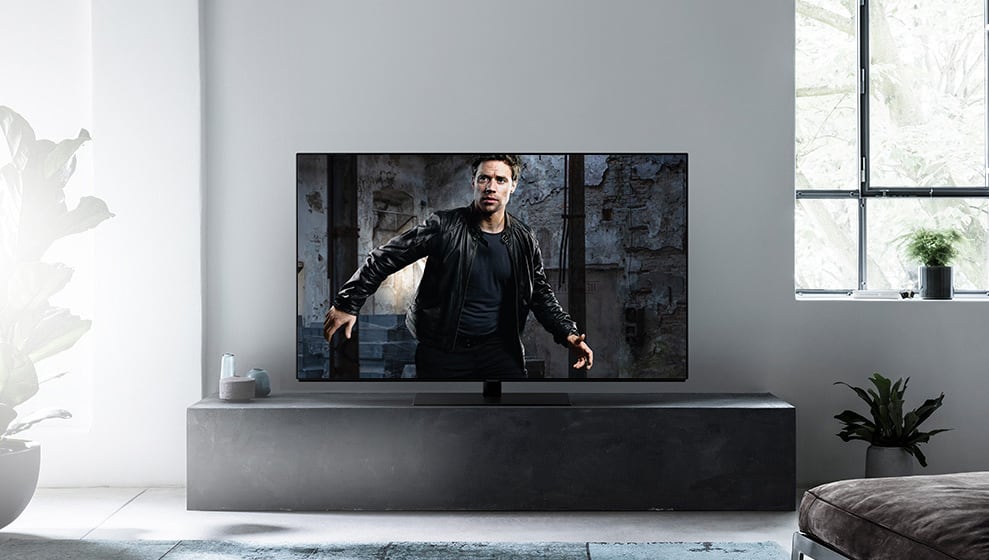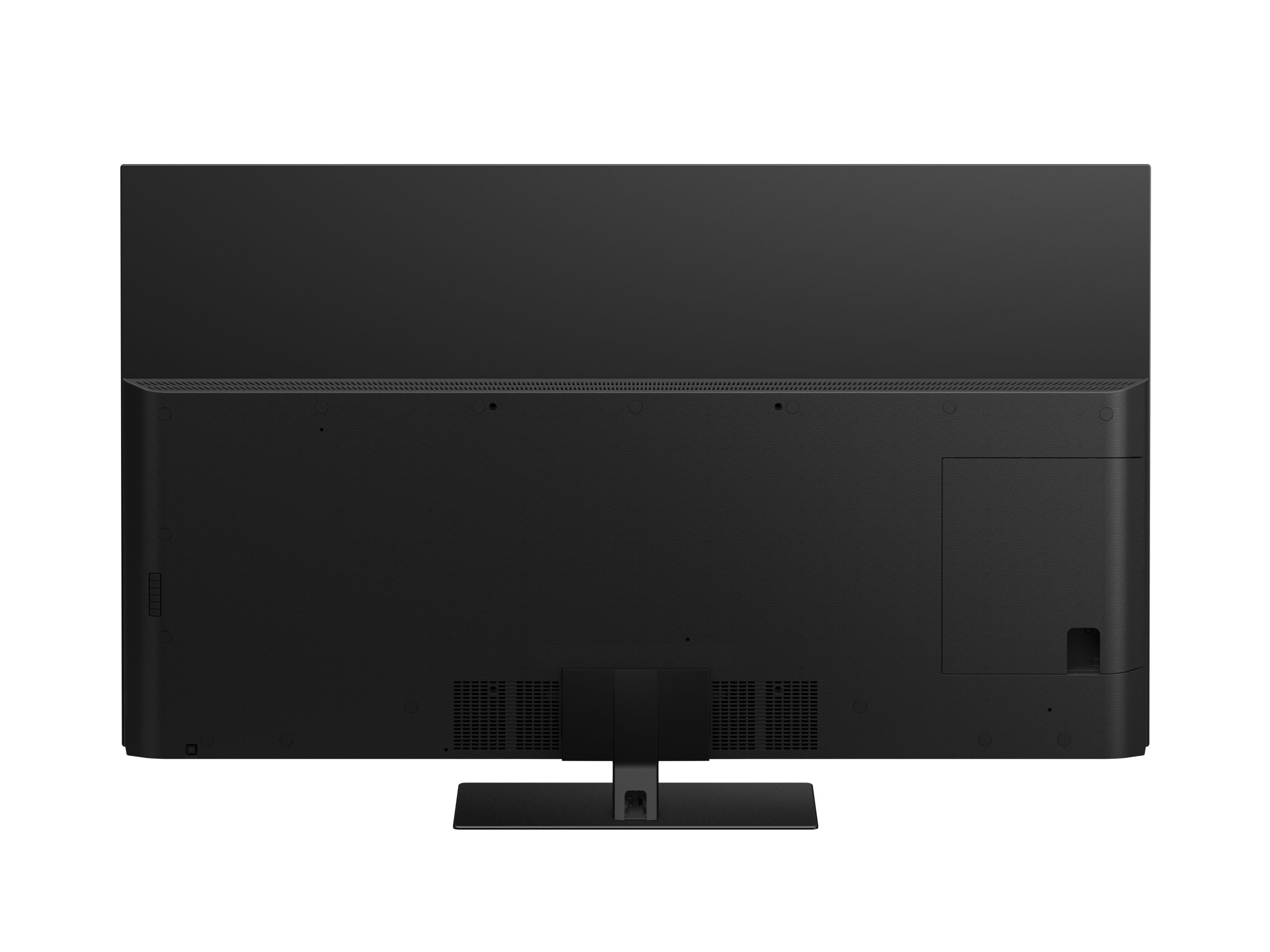Panasonic has a solid track record when it comes to delivering high-performance TVs. The best model TX-65GZ2000E remains one of the roughest TVs we tested in 2019, with a contrast and color quality on a par with a professional studio monitor! The only sour thing about the GZ2000 is that it costs 5,000, which is stiff for a 65 ”OLED, regardless of quality.
If you are price conscious and want the best possible picture for a more sober sum of money, it may be worth checking out the little brother Panasonic TX-65GZ960E, which is Panasonic’s most affordable OLED TV from 2019. This is a more scaled-down variant, without the top model’s professional OLED panel and built-in Atmos speakers. In return, you can save 2,000, and still get an image quality that is very close to the top model.
Design

The Panasonic GZ960 has an aesthetically sober and minimalist appearance. Both the picture frame and the square plinth are in a dark metal design. The dark color is very viewer-friendly, without any shiny details that disturb the look. The GZ960 is also significantly slimmer and lighter than its big brother GZ2000, since it has no extra speakers on the back. On the other hand, it has a recessed pocket for connections, and covers for hidden cable routing down through the base.
Ease of use and features
The GZ960 uses Panasonic’s proprietary user interface and menu system. The so-called MyHomeScreen seems a bit outdated compared to the latest versions of Android, WebOS (LG) and Tizen (Samsung). Panasonic’s remote control is also starting to get a few years on its back: We would have liked to have imagined a more modern variant with fewer buttons.
That said, the system feels comfortable to use. The home screen provides quick access to TV channels, apps and connected devices, and the menus are easy to get acquainted with.
The GZ960 supports both HDR10 + and Dolby Vision which are the two most important HDR formats with dynamic contrast. This ensures that almost all of the video content, whether it comes from e.g. Netflix, Amazon Prime or UHD Blu-ray can be viewed in the best available format and quality. Definitely an important point if you are an avid series and film enthusiast.
The Panasonic monitor’s HDMI inputs support ALLM (Auto Low latency mode) which automatically switches to game mode when it detects a game console. We measured the delay (input layer) to around 22 ms. It’s not as record low as LG’s OLED screens, but fast enough for most people.
Image quality
Although the GZ960E is a scaled-down version of the GZ2000, it turns out that Panasonic has retained many of the features that affect image quality. The biggest physical difference lies in the image panel itself, where the GZ960 has to cope with a standard 4K OLED panel, rather than the modified professional panel (with improved mechanical cooling and higher brightness) that sits in the top model. The image processing, however, is identical: Here, the GZ960 uses the new HCX Pro, which is the Japanese’s fastest and most advanced “image engine”. All the pre-programmed picture modes (including THX Cinema and Netflix Calibrated Mode) are also in place.
Thus, it comes as no great surprise that the GZ960 delivers an image quality that is very close to the top model.
We are first impressed by the extremely strong and precise contrast: the Panasonic screen has a very precise reproduction all the way from the dark to the light, and brings out even the smallest details without messing it up. The black level is also, as we are used to with OLED in general and Panasonic in particular, extremely good in several ways. The darkest tones are completely carbon black, but the GZ960 also manages to bring out details in dark scenes, which easily drown out on less capable screens. Here, there are no tendencies to so-called “black crush” or noise as we see tendencies at LG and Philips, among others. Thus, even grayscale and dark, demanding movies like Terminator Salvation become a pure pleasure to watch.
The color reproduction is also excellent. Here, red looks like real red, warm and intense without being oversaturated. Green grass no longer looks like artificial plastic, but gets a more organic feel. Skin tones are also natural, and the color gradations are reproduced without visible shades. The Panasonic screen is actually one of the best we have seen “out of the box”. Support for Calman Autocal is also in place, so that anyone who wants (and has access to the right measuring equipment) can have the screen calibrated to near perfection. This is in line with Panasonic’s goal of fulfilling the film director’s intentions and bringing “Hollywood to your Home” as it is so nicely named.
The GZ960 also has very smooth movements. Panasonic’s “Intelligent Frame Creation” motion smoothing does a good job of smoothing the images without introducing a striking “soap opera” effect. Here, however, we see a slight difference from the competitor Philips OLED804, which is chopped more evenly on feature films filmed in 24p (frames per second). While Panasonic does a similar “hiccup” on a regular basis, the Philips screen is super smooth all the way.
To get the most out of the Panasonic screen, however, it is important to take a small step: Hidden in one of the submenus is a power saving function. The GZ960 is equipped with a light sensor, which automatically dims the brightness in relation to lighting conditions in the room. We found that this was a little too aggressive and took away too much light, and preferred to drop the power saving for the sake of performance.
The biggest difference between the GZ960 and GZ2000 lies in the brightness. While the flagship manages to squeeze out as much as 900 nits in the brightest parts, the GZ960 is on a par with regular OLED screens, ie around 700 nits. This is first and foremost noticeable on content in HDR quality, in that bright areas such as sunlight, flames and the like do not feel as shiny and intense as on the top model. With regular TV viewing and SDR (Standard Dynamic Range) content, however, there is hardly any noticeable difference.
Slim sound quality
The Panasonic TX-65GZ960 has a long way to go after the Technics sound system that the GZ2000 comes equipped with: Here you get a significantly simpler variant with standard stereo speakers, without surround effect. Unfortunately, the built-in speakers do not seem to have much fun. The sound is relatively slim, muted and stuffy, and compared to the Philips OLED804 it actually sounds downright sad. It is worth mentioning the possibility of connecting an external subwoofer, but we would rather recommend upgrading the sound image completely using a sound board. Heldigivs supports the GZ960 decoding of Dolby Atmos internally, so that it can transmit the audio signals to a compatible audio board via HDMI ARC. This is useful for utilizing the sound potential that lies in e.g. Netflix’s original series with Atmos sound.
Conclusion
The Panasonic TX-65GZ960E is basically a scaled-down version of the flagship model GZ2000. But this is definitely not a B-item: In fact, the GZ960 is more like the big brother than we had expected, given the big price difference. Here you get a contrast, color reproduction and general image dynamics that are in clear high-end class. Add broad support for all the important video formats, and you have a TV that is tailored for cinematic enjoyment. The sound, on the other hand, is not something to cheer about: We therefore recommend everyone who is interested, to add a proper soundboard to the budget.

We think
TX-65GZ950E provides sparkling good image quality, with contrast and color performance that is very close to the top models, at a far more pleasant price. The sound is unfortunately slack in the fish. Soundboard is therefore a must!
2999 €
Specifications
- Size / type: 65 ”4K OLED
- Resolution: 3840×2160 (4K Ultra HD)
- Operating System: My Home Screen 4.0
- Inputs: 4 HDMI (2.0b), 3 USB
- Outputs: Optical digital audio output
- HDR: Dolby Vision, HDR10 +, HLG
- Other: Dolby Atmos, HCX Pro video processor
- Web: panasonic.com


